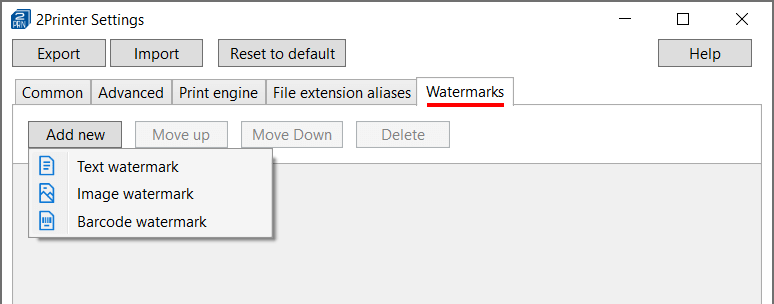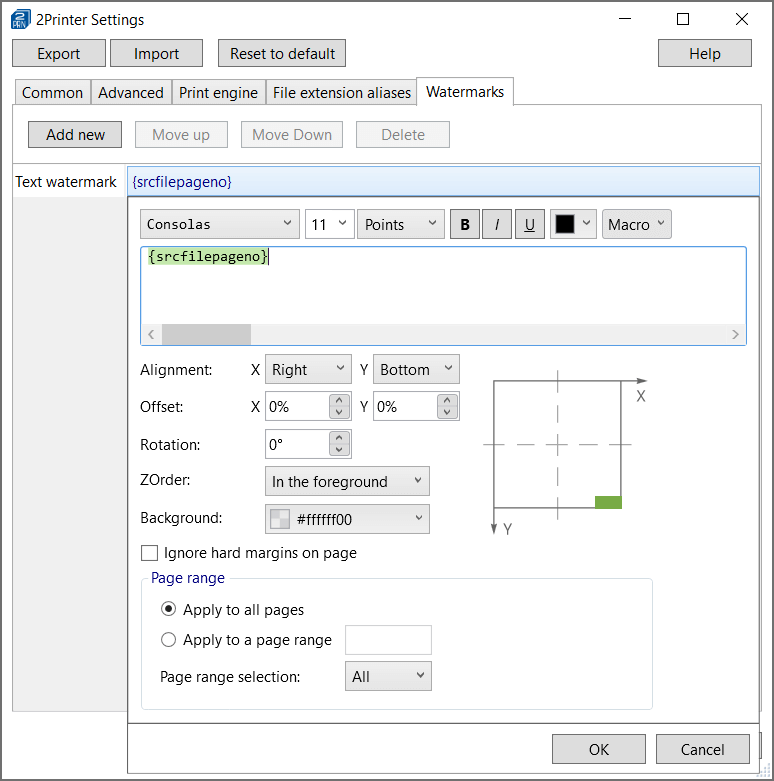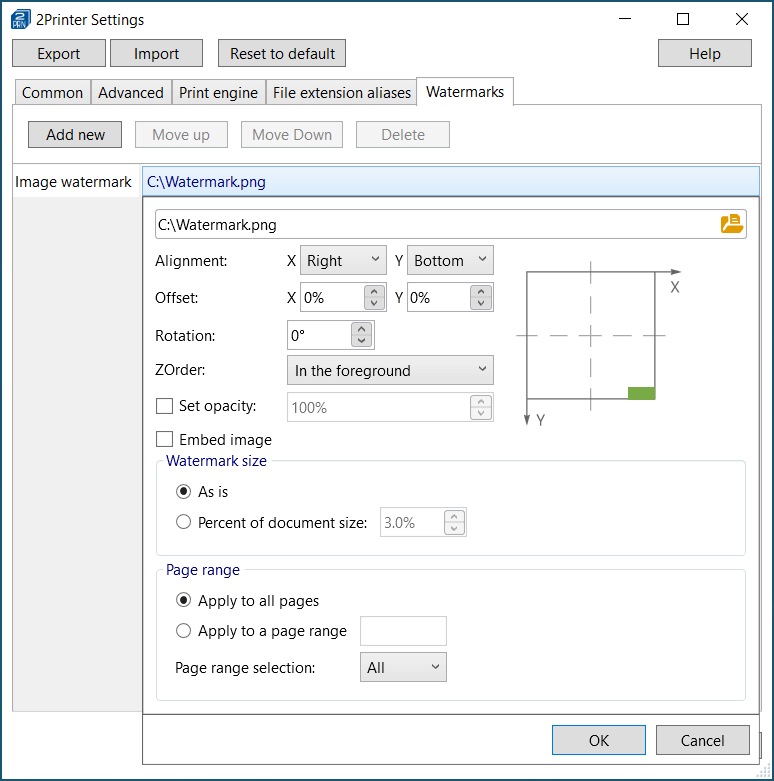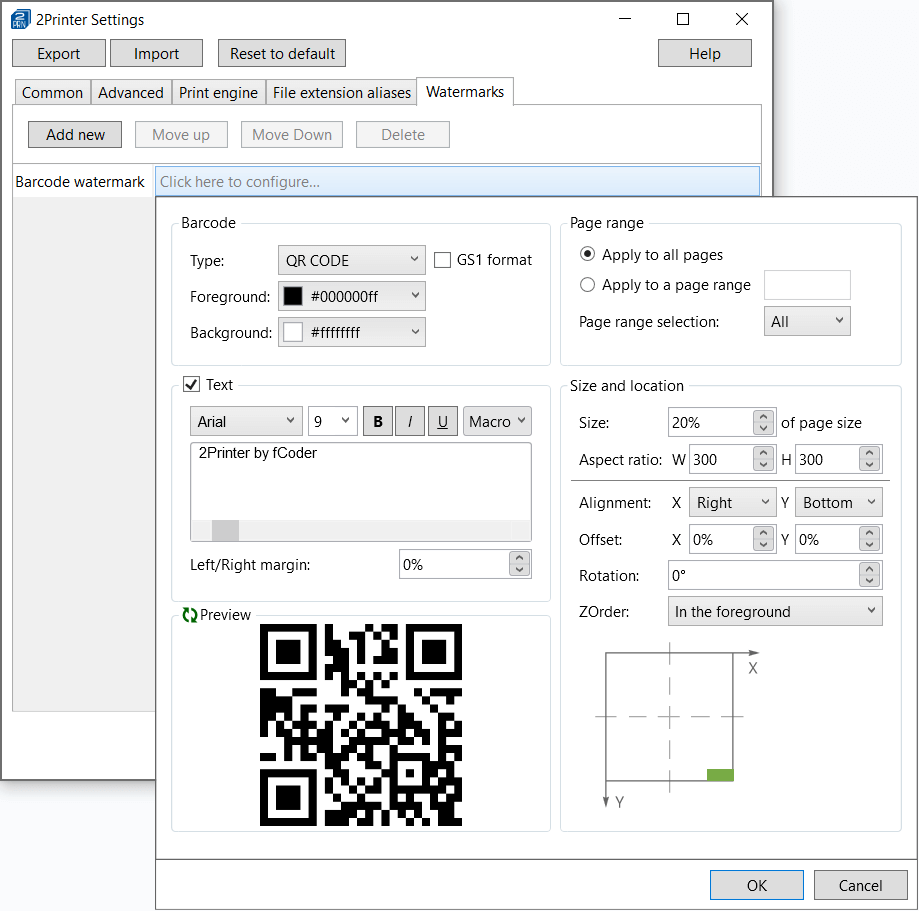2Printer allows you to add a customizable watermark before printing. Three types of watermarks are available: Text watermark, Image watermark, and Barcode watermark. Multiple watermarks can be added at once.

Watermarks configured through 2Printer Settings will be applied to all files printed by the program. If you only want to add watermarks in specific commands of 2Printer, you can use the switches -oper watermark (for image watermarks) or -oper textwatermark (for text watermarks) as described in the command line Syntax.
Text watermark
Text watermark lets you add text to printed pages. You can create a text watermark using:
- Plain text
- Macros
- Plain text + macros

Here you can adjust text style and use various built-in macros that can help you add page numbers, file date and time, original document name, and other source file data.
Description of all Text watermark macros
To add source file data, you can use and combine various macros. Click the Macro button to select a macro to be used.
| Macro name/Group of macros | Macro | Description |
|---|---|---|
| Filename | ||
| Source file name | {SrcFileName} | File name (without extension).Example: Document_A |
| Regular expression of source file name | {SrcFileName("^(\d+)")}, {SrcFileName("(\d+)$")} and others | Various parts of the source file's name:Take digits from the beginningTake digits from the endTake any first symbols after dashCut "quick brown fox" from filenameCut one character |
| Source file extension | {SrcFileExt} | File extension.Example: docx |
| Source file folder | {SrcFileFolder} | Folder path where the file is located. Example: C:\Work\Folder_A\Subolder_A |
| Source file folder name | {SrcFileFolderName} | File directory name (file location name). Example: Subfolder_A |
| Source file path | {SrcFileFullpath} | Full path to the source file, including the filename.Example: C:\Work\Folder_A\Subfolder_A\Document_A.docx |
| Source file path, 1-st part | {SrcFileFullpath(1)} | The first part of the file path (not including the drive letter) Example: Work |
| Source file path, 2-nd part | {SrcFileFullpath(2)} | The second part of the file pathExample: Folder_A |
| Source file path, 3-rd part | {SrcFileFullpath(3)} | The third part of the file pathExample: Subfolder_A |
| Source file type | {SrcFileType} | File type. For example: Microsoft Office Word |
| Container name | {ContainerName} | Name of an email message file, an archive (RAR, ZIP, 7ZIP), or a PDF Portfolio file. |
| File attributes | ||
| Source file date | {SrcFileDate} | Date of file processing by 2Printer |
| Source file time | {SrcFileTime} | Time of file processing by 2Printer |
| Source file author | {Author} | Name of the user who created the file |
| Source file creator | {Creator} | Software with which the file was created |
| Source file custom text | {CustomText} | User-specified text which can be added to any list item. Note: if you have several columns in the list of files, use {customtext}, {customtext(2)}, {customtext(3)}, etc. |
| Source file pages | {SrcFilePages} | The total number of pages |
| Source file page number (numeric format) | {SrcFilePageNo} | The number of a page that is being printed, in numeric format ("1", "2", "3") |
| Source file page number (text format) | {SrcFilePageNo(Words)} | The number of a page that is being printed, in numeric format ("one", "two", "three") |
| User name | {User} | User account name in Windows |
| Computer name | {Computer} | Computer name in Windows |
| Date/Time | {Date(M-d-yyyy)}, {Time(h-mm-ss tt)}, and more | Several macros that insert date and time (in various formats). They include Full date, Full time, Date, Date (DD.MM.YYYY), Year, Month, Day, Time, Time (HH:MM:SS), Hour, Minute, Second, Millisecond |
| Copies | {Copies} | File's total number of copies |
| Copy | {Copy} | Current copy number. Please note that this macro works properly only when Single print job mode is enabled. |
| Item number in the List | {ListItemNo} | Item's index number (the very first column named "#") in the list of files |
| Numbering for Lists | ||
| Total pages in the List | {TotalPages} | The total number of pages of all items added to the list of files |
| Consecutive page number in the List | {ConsecutivePageNo} | Consecutive page numbers are counted within all items added to the entire List of Documents. This type of page numbering is also known as "Continuous page numbering across multiple documents" or simply "consecutive numbering," where all pages from a sequence of several documents are numbered continuously. Note: this macro works correctly only when printing with Single print job mode enabled. |
Text watermark parameters
If you're using your own text, you can customize it your way – adjust font, offset, margins, background, rotation, and more. These are available parameters:
| Setting or interface element | Functionality |
|---|---|
| Font | Set stylistic attributes of a font: font type, color, size |
| Watermark text | Type any text or use macros. {srcfilepageno}, set by default, stands for source file page number |
| Alignment | X-axis alignment: Left, Center, Right Y-axis alignment: Top, Center, Bottom |
| Margins | X and Y-axis margins: set any value in points equal to 0.01 inch |
| Rotation | Adjust the angle of watermark rotation to a certain degree |
| Background | Select color behind the text |
| ZOrder | Set watermark Z-axis position: In the foreground or In the background |
| Ignore hard margins on page | Ignore the printable area applied by default by some printers and use the dimensions of the paper sheet only |
Image watermark
To insert a watermark from an image file, follow these steps:
1. Choose the image file that you want to use as the watermark.
2. Customize the size, position, transparency, and other settings as needed. By default, the watermark is added to the right-bottom corner of a page or image.
3. Optionally, specify the pages where the watermark should appear.

Image watermark parameters
| Setting or interface element | Functionality |
|---|---|
| File selection | Browse for the file to be used as a watermark. Popular formats, such as JPG, PNG, HTML, PDF are supported |
| Alignment | X-axis alignment: Left, Center, Right Y-axis alignment: Top, Center, Bottom |
| Offset | Set X and Y offset as a percentage of the document height/width. You can enter positive or negative values to "move" the watermark |
| Rotation | Adjust the angle of watermark rotation to a certain degree |
| ZOrder | Set watermark Z-axis position: In the foreground or In the background |
| Set opacity | Change opacity to make watermark semi-transparent |
| Embed image | Enabling this option will save the image in the 2Printer local folder. It can be used for loading presets |
| Watermark size | Select the original size (As is) or set the watermark size as a percentage of the document's page size |
| Page range | Select all pages or specify individual pages or a range of pages |
Barcode watermark
You can create and customize a barcode to be printed using the Barcode watermark operation. This feature allows you to insert barcodes, such as QR codes, onto document pages. Multiple barcode types are available, including Code 128, EAN, UPC, QR-CODE, and more.
The settings that can be configured here are similar to those of Text watermark and Image watermark.

You may also like to read:
Need help with configuration? Please contact us.